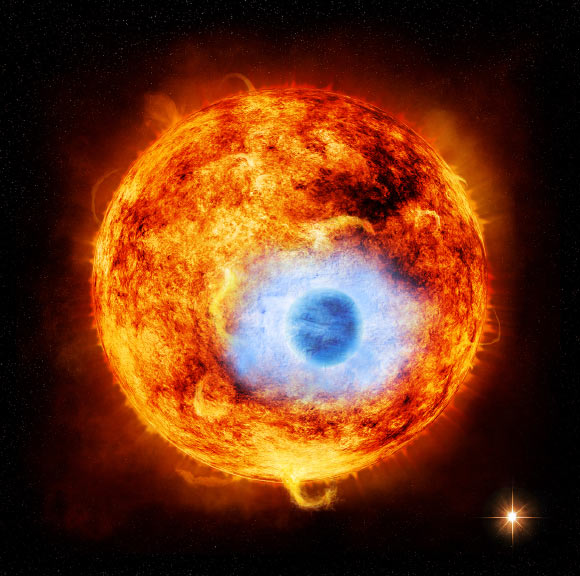A research team led by Princeton University astrophysicists has discovered a co-moving pair of bright Sun-like stars, HD 240430 and HD 240429, with a significant difference in their chemical abundances. According to the team, one of the two stars — HD 240430 (nicknamed Kronos) — shows signs of having ingested 15 Earth masses worth of rocky planets.
“Dubbed Kronos after the child-eating Titan of Greek mythology, HD 240430 is the clearest and most dramatic case yet of a Sun-like star consuming its own planets,” said lead author Semyeong Oh, an astrophysicist at Princeton University.
“Even if our Sun ate the entire inner Solar System, it wouldn’t come close to the anomaly we see in Kronos,” added Dr. David Hogg, of the Flatiron Institute.
Kronos and HD 240429 (dubbed Krios) are members of a wide binary system.
They have an estimated 3D separation of 2 light-years (0.03 light-years projected) at a distance of 326 light-years, and orbit each other infrequently, on the order of every 10,000 years or so.
Both stars are 4 billion years old, and like our own, slightly older Sun, both are yellow G-type stars.

Planet-eating star HD 240430 and its binary twin HD 240429 are about 326 light-years away from Earth. Image credit: STScI Digitized Sky Survey.
Binary stars are typically near-identical twins. Kronos and Krios, however, have vastly different chemical makeups, including the largest difference in metal content of any binary system yet studied.
“The keys to the discovery were first confirming that the widely separated pair are in fact a binary pair, and secondly observing Kronos’ strikingly unusual chemical abundance pattern,” Oh said.
“Other co-moving star pairs have different chemistries, but none as dramatic as Kronos and Krios.”
“Most stars that are as metal-rich as Kronos have all the other elements enhanced at a similar level, whereas Kronos has volatile elements suppressed, which makes it really weird in the general context of stellar abundance patterns.”
In other words, Kronos has an unusually high level of rock-forming minerals, including magnesium, aluminum, silicon, iron, chromium and yttrium, without an equally high level of volatile compounds — those that are most often found in gas form, like oxygen, carbon, nitrogen and potassium.
“Kronos is already outside the galactic norm, and in addition, because it has a stellar companion to compare it to, it makes the case a little stronger,” Oh said.
Oh and co-authors propose that Kronos’ changed composition arose after flying close to another star.
“Gravitational interactions with the passing star stretched the orbits of Kronos’ outermost planets so that they ended up passing through the inner planetary system,” they explained.
“Their gravity in turn sent rocky inner planets on doomsday trajectories into the star.”
“If this explanation is correct, future data releases may reveal planets with highly elliptical orbits around Kronos,” Oh said.
“Kronos’ twin Krios evidently either remained far enough away from other stars so that its planetary system remained unaffected or had fewer rocky planets to consume.”
Details of the research are publicly available at arXiv.org.
_____
Semyeong Oh et al. 2017. Kronos & Krios: Evidence for accretion of a massive, rocky planetary system in a comoving pair of solar-type stars. arXiv: 1709.05344








